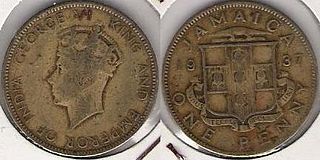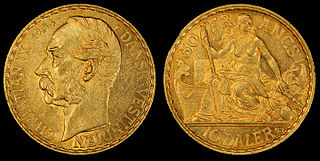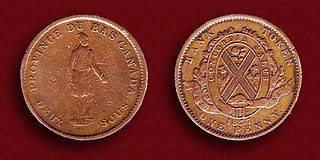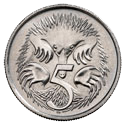Coins of the United States dollar - aside from those of the earlier Continental currency - were first minted in 1792. New coins have been produced annually and they comprise a significant aspect of the United States currency system. Circulating coins exist in denominations of 1¢, 5¢, 10¢, 25¢, 50¢, and $1.00. Also minted are bullion, including gold, silver and platinum, and commemorative coins. All of these are produced by the United States Mint. The coins are then sold to Federal Reserve Banks which in turn put coins into circulation and withdraw them as demanded by the United States economy.

The Australian dollar is the official currency and legal tender of Australia, including all of its external territories, and three independent sovereign Pacific Island states: Kiribati, Nauru, and Tuvalu. In April 2022, it was the sixth most-traded currency in the foreign exchange market and as of Q4 2023 the seventh most-held reserve currency in global reserves.

The New Zealand dollar is the official currency and legal tender of New Zealand, the Cook Islands, Niue, the Ross Dependency, Tokelau, and a British territory, the Pitcairn Islands. Within New Zealand, it is almost always abbreviated with the dollar sign ($). The abbreviations "$NZ" or "NZ$" are used when necessary to distinguish it from other dollar-denominated currencies.

Legal tender is a form of money that courts of law are required to recognize as satisfactory payment for any monetary debt. Each jurisdiction determines what is legal tender, but essentially it is anything which when offered ("tendered") in payment of a debt extinguishes the debt. There is no obligation on the creditor to accept the tendered payment, but the act of tendering the payment in legal tender discharges the debt.

The Singapore dollar is the official currency of the Republic of Singapore. It is divided into 100 cents. It is normally abbreviated with the dollar sign $, or S$ to distinguish it from other dollar-denominated currencies. The Monetary Authority of Singapore (MAS) issues the banknotes and coins of the Singapore dollar.

The Sri Lankan Rupee is the currency of Sri Lanka. It is subdivided into 100 cents, but cents are rarely seen in circulation due to its low value. It is issued by the Central Bank of Sri Lanka. The abbreviation Re (singular) and Rs (plural) is generally used, the World Bank suggests SL Rs as a fully disambiguating abbreviation for distinction from other currencies named "rupee".

The pound was the currency of Australia from 1910 until 14 February 1966, when it was replaced by the Australian dollar. Like other £sd currencies, it was subdivided into 20 shillings, each of 12 pence.
The Bermudian dollar is the official currency of the British Overseas Territory of Bermuda. It is subdivided into 100 cents. The Bermudian dollar is not normally traded outside Bermuda, and is pegged to the United States dollar at a one-to-one ratio. Both currencies circulate in Bermuda on an equal basis.

The Trinidad and Tobago dollar is the currency of Trinidad and Tobago. It is normally abbreviated with the dollar sign $, or alternatively TT$ to distinguish it from other dollar-denominated currencies. It is subdivided into 100 cents. Cents are abbreviated with the cent sign ¢, or TT¢ to distinguish from other currencies that use cents. Its predecessor currencies are the Trinidadian dollar and the Tobagonian dollar.

The dollar has been the currency of Liberia since 1943. It was also the country's currency between 1847 and 1907. It is normally abbreviated with the sign $, or alternatively L$ or LD$ to distinguish it from other dollar-named currencies. It is divided into 100 cents.

The Solomon Islands dollar is the currency of Solomon Islands since 1977. Its symbol is $, with SI$ used to differentiate it from other currencies also using the dollar sign. It is subdivided into 100 cents.
The Tuvaluan dollar is one of the currencies of Tuvalu, whose unofficial international currency code is TVD. Tuvalu has never had banknotes of its own, and has been issuing coins since 1976. However, the Tuvaluan dollar is used as a unit of account, and is pegged to the Australian dollar at parity. From 1966 to 1976, Tuvalu officially used the Australian dollar. In 1976, Tuvalu began issuing its own coins, which continue to circulate alongside Australian coins. Tuvalu continues to use Australian banknotes. Tuvaluan coins are not legal tender in Australia. Similar to the Faroese króna's relationship to the Danish krone and the Panamanian balboa's relationship to the United States dollar, the Tuvaluan dollar is not an independent currency, but a variation of the Australian dollar.

The pound was the official currency of Jamaica between 1840 and 1969. It circulated as a mixture of sterling coinage and locally issued coins and banknotes and was always equal to the pound sterling. The Jamaican pound was also used in the Cayman and Turks and Caicos Islands.

The Cook Islands dollar was the former currency of the Cook Islands, which now uses the New Zealand dollar, although some physical cash issued for the Cook Islands dollar remains in use. The dollar was subdivided into 100 cents, with some older 50-cent coins carrying the denomination as "50 tene".

The daler was the currency of the Danish West Indies between 1849 and 1917, and of the United States Virgin Islands between 1917 and 1934.

The pound was the currency of the Canadas until 1858. It was subdivided into 20 shillings (s), each of 12 pence (d). In Lower Canada, the sou was used, equivalent to a halfpenny. Although the £sd accounting system had its origins in sterling, the Canadian pound was never at par with sterling's pound.

The Australian five-cent coin is the lowest-denomination circulating coin of the decimal Australian dollar introduced in 14 February 1966, replacing the pre-decimal sixpence. It has been the lowest-denomination coin in general circulation since the withdrawal of the one-cent and two-cent coins in 1992.
The coins of the Australian dollar were introduced on 14 February 1966, although they did not at that time include the one-dollar or two-dollar coins. The dollar was equivalent in value to 10 shillings in the former currency.
The coins of the New Zealand dollar are used for the smallest physical currency available in New Zealand. The current denominations are ten cents, twenty cents, fifty cents, one dollar and two dollars. The $1 and $2 coins are minted in a gold colour, the 20c and 50c coins are silver colour and the 10c coin is plated in copper.
Niue, a country in free association with New Zealand, uses only one official legal tender currency, which is the New Zealand dollar.













